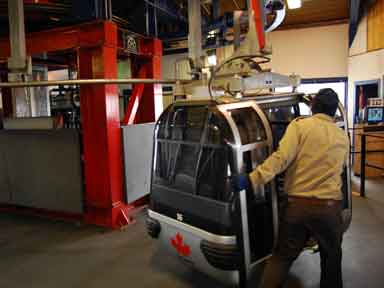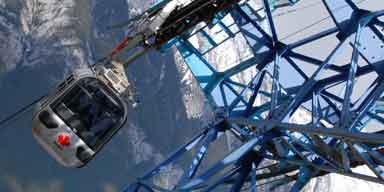Banff, Alberta, Canada has probably one of the most unique gondola systems in the world.
Well, actually they’re all unique. I’ve rarely found two systems that are alike and that’s the both the technology’s blessing and its curse. Yes, each system is different and unique to its own situation. Systems can be configured in any manner you like and that’s a good thing because it means each system is custom. Conversely, however, it means that explaining the technology is difficult because there are no off-the-shelf systems that would be appropriate in an urban setting.
Light Rail, Subways and Buses – on the other hand – are easy to explain because there’s really only one or two ways to configure/install a system.
Nevertheless . . .
The Sulphur Mountain Gondola is a fairly innocuous tourist installation. The system is two or three decades old and has almost comically small vehicles that fit only 4 people. The cars are so small in fact that it’s near impossible to stand up inside them unless your a child. This is fairly typical of old systems and not really worthy of comment.
What is worthy of comment however is this: Like all BDG systems, the Sulphur Mountain Gondola detaches from its haul rope in the station terminals. But this is where things get odd. Whereas virtually every other detachable gondola is moved through the station via a system of wheels, gears and/or conveyors the Sulphur Mountain Gondola is moved through the terminal by hand.

The Sulphur Mountain Gondolas are moved through the station terminals by station attendants. Image by Steven Dale.
Vehicles are literally pushed by station attendants through the terminals. Station attendants stop the vehicles, allow people to get on and off, and are then moved through the station. Vehicles are then reaccelerated and positioned online by computer control.
So why is this important?
It’s current practice for vehicles to move through the stations at what is known as “crawl” or “creep” speed. Boarding and alighting is done while the vehicles are in motion, ever so slowly “crawling” through stations. Some people will complain that this represents a barrier to accessibility. The truth is that “crawl speed” is so slow that boarding and alighting is simple for virtually everyone. For everyone else, meanwhile, vehicles can be stopped by computer so that people may board and alight with a stationary vehicle.
But for some people that won’t be enough. For those people, vehicles crawling through a station represents a barrier to accessibility, full-stop. If they’ve made up their minds already and have the narrative fixed firmly in place the above solutions are probably not enough to change their worldview. What the Sulphur Mountain Gondola demonstrates is that there is no technological reason that vehicles cannot come to a complete stop in stations as a matter of practice, every time.
Doing so would eliminate any accessibility arguments and make the technology feel more familiar as transit. Maybe the cable industry should consider doing away with “crawl speed” for urban systems altogether. After all, no one boards an LRT vehicle while it’s still in motion.

